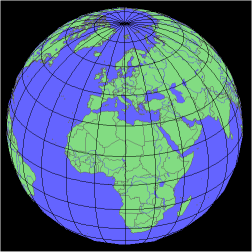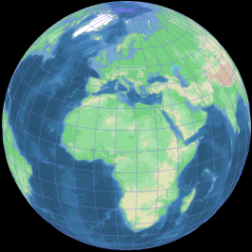OrthographicProjection Class
Represents the orthographic map projection (the Earth seen from outer space).
NuGet/Assembly: Carmenta.Engine.5.17.0.nupkg (in the CECore assembly)
Syntax
public class OrthographicProjection : ProjectionRemarks
The orthographic map projection gives a perspective 2D image of the Earth, using parallel rays. In other words, the observer is very far away, so he can see exactly one hemisphere.
 |
 |
If you want to display a globe, it is nearly always much better to use a true 3D presentation based on a GlobeView than to use an orthographic map projection in a 2D map. However, the implementation of the orthographic map projection predates the GlobeView, and the projection can be used to simulate a spinning globe in a 2D map. This is done with a special built-in behavior of StandardTool: if this tool is used for panning with an orthographic View.Crs, and if StandardTool.UpdateMode = Live, then the tool will implement panning in a non-standard way that simulates a spinning globe in 2D. Technically, the View.Crs is replaced by a similar one where the orthographic projection parameters have been modified.
If you try this in Carmenta Explorer, note that you can switch between the two tool update modes via the drop-down menu of the "Standard Tool 2D" button, where you can check or uncheck "Use bitmap pan and zoom".
The only advantage of the orthographic projection is its striking three-dimensional appearance in 2D. It not useful for cartometry, since it is neither conformal, nor equal area, nor anything else that is useful.
If you need to display one particular hemisphere in 2D - for a map of the Pacific Ocean, for example - it may be better to use the stereographic, or the azimuthal equidistant, or the Lambert azimuthal equal-area projection instead.
Inheritance Hierarchy
System.Object
EngineObject
ResourceObject
Projection
OrthographicProjection
Platforms
Windows, Linux, Android
OrthographicProjection Members
The OrthographicProjection type has the following members.
Constructors
| Name | Description |
|---|---|
| OrthographicProjection | Initializes a new instance of the OrthographicProjection class from parameters. |
Properties
| Name | Description |
|---|---|
| Authority | Gets the name of an authority, which is often "epsg". Inherited from Projection |
| AuthorityCode | Gets the unique code for the projection instance, according to the Authority, for example "19883". Inherited from Projection |
| CentralLatitude | Gets the central latitude, also known as latitude of origin. |
| CentralLongitude | Gets the central longitude, also known as central meridian or longitude of origin. |
| FalseEasting | Gets the offset added to the projected x coordinates (the eastings). |
| FalseNorthing | Gets the offset added to the projected y coordinates (the northings). |
| IsDisposed | Gets a value that tells whether the current OrthographicProjection has been disposed. Inherited from EngineObject |
| LengthUnit | Gets the length unit of the projected coordinates. |
| Gets a pre-defined LongLatProjection instance. Inherited from Projection | |
| Name | Gets or sets the name of the OrthographicProjection. Inherited from ResourceObject |
| NativeHandle | Gets the native Carmenta Engine kernel object the current OrthographicProjection represents. Inherited from EngineObject |
| IUserProperties.UserProperties | Gets the AttributeSet that contains the user properties. Inherited from IUserProperties |
Methods
| Name | Description |
|---|---|
| Clone | Creates a copy of an object. Inherited from EngineObject |
| Dispose | Releases the reference to the native Carmenta Engine kernel instance the EngineObject represents. Inherited from EngineObject |
| Equals | Determines whether this instance is equal to another. Inherited from EngineObject |
| Set | Modifies the calling OrthographicProjection, giving it a new geographic center. |
| Returns one of the 120 predefined instances of Universal Transverse Mercator. Inherited from Projection |